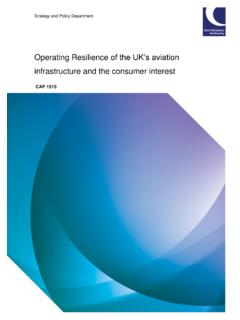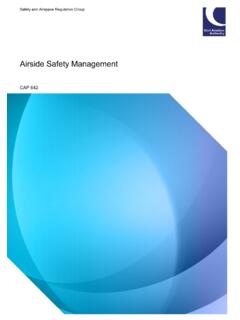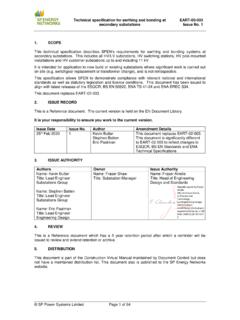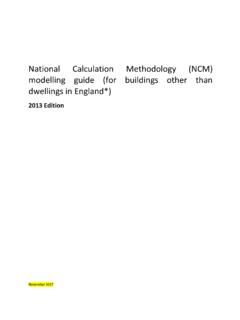Transcription of Drone Safety Risk: An assessment - CAA
1 Drone Safety Risk: An assessment CAP 1627 Published by the Civil Aviation Authority, 2018 Civil Aviation Authority Aviation House Gatwick Airport South West Sussex RH6 0YR You can copy and use this text but please ensure you always use the most up to date version and use it in context so as not to be misleading, and credit the CAA. First published 2018 The latest version of this document is available in electronic format at: January 2018 Page 3 Contents 1. Executive summary 4 2. The risk picture 7 How risk has been assessed 7 The CAA s approach 10 Drone usage: an overview 12 3. What is at risk?
2 15 What damage could a Drone collision cause to an aircraft? 16 Windscreen/canopy 16 Engine(s) 18 Wing/tailplane leading edges 19 Undercarriage/flaps/spoilers 19 Flying control surfaces 20 Rotors 21 Evaluating the risks 21 Severity 23 Likelihood 23 4. Next steps 30 Abbreviations 32 The Drone Code 33 2017 Drone MOR Data 35 Executive summary January 2018 Page 4 1. Executive summary The Civil Aviation Authority (CAA) supports the safe development of drones in the UK. Drones can bring economic and workplace Safety benefits, but to achieve those we need everyone flying a Drone to do so safely. The use of small unmanned aircraft, more commonly known as drones, is rising in the UK, for both leisure and commercial purposes.
3 With that increase in usage comes more questions about the unintentional risks of drones colliding with, or disrupting, manned aircraft. At the time of writing there have been seven confirmed cases of direct in flight contact between drones and civil or military manned aircraft worldwide1. There have been no known collisions between small drones and manned aircraft in the UK. However, the number of occasions where pilots have reported suspected drones in proximity to their aircraft in the UK is increasing; there were 59 such occasions between April 2016 and March 2017. Two of these involved large passenger air craft near Heathrow, leading to concerns being voiced in Parliament, in the media and by a range of aviation bodies about the possible impact of a collision between a passenger aircraft and a Drone .
4 A further incident in July 2017, where an object believed to be a Drone was seen near Gatwick, led to the runway being closed briefly and flights being diverted. The CAA has undertaken an assessment of available information about the likelihood of an unintentional Drone collision and the severity of any possible impact between an aircraft and a smaller unmanned vehicle (defined as under 2kg in this report). The findings are: The drones most likely to end up in proximity to manned aircraft are smaller drones, typically of 2kg or less, flown by operators who either do not know the aviation Safety regulations or have chosen to ignore them.
5 It is considered unlikely that a small Drone would cause significant damage to a modern turbo-fan jet engine; even if it did, a multi-engine aircraft would still be likely to be able to land safely. 1 Aviation Safety Network Drone database, 14th Dec. 2017 - 7 confirmed and 6 suspected collision events worldwide. ( )) Executive summary January 2018 Page 5 The likelihood of a small Drone being in proximity of a passenger aircraft when it is travelling fast enough to potentially damage a windscreen is currently observed to be about 2 per million flights, where proximity means within visual line of sight of the aircraft.
6 The likelihood of a small Drone actually hitting a passenger aircraft windscreen at sufficient speed to rupture it is very much smaller than the probability of it being in the proximity of an aircraft. The windscreens of small helicopters and light aircraft are more susceptible to rupture if struck by a small Drone , even when flying below normal cruising speed. Helicopters face more particular risks because of the additional susceptibility of helicopter rotors to damage from a collision with a Drone , and their operating patterns which typically involve lower-level flying and take-off and landing from a range of sites.
7 The standards of design and production of large passenger aircraft may provide some reassurance about the risk to life associated with a small Drone collision. However, they raise concerns about the risks to other manned aviation. The CAA has produced a bowtie Safety assessment model examining potential mitigations to these risks. At present, all such mitigations which range from Drone operator education to pilot action to enforcement to technical limitations on drones remain essential to ensure the separation of small drones and all manned aircraft. Achieving this separation with high levels of confidence and consistency is the only way of securing high levels of aviation Safety .
8 It is critically important that those who operate drones always do so within the regulations and guidelines set by the CAA or Government Departments. The risk of collision is a complex issue that depends on the interaction of many factors. For example, an increase in Drone ownership may not automatically increase the probability of a collision if those drones are flown rarely or if they are flown in accordance within the Safety rules and therefore away from aircraft. Comprehensive data about the frequency and nature of Drone use is very limited, and therefore a reliable predictive model that would enable an assessment of changes to key risk factors is not possible at the current time.
9 The assessment contained in this report is based on observed numbers of reported Drone proximity events. The prime responsibility for establishing research programmes into collision consequences rests with the aircraft certification authorities; in the UK, as in the rest of Europe, this is the European Aviation Safety Agency (EASA). In the US, the Federal Aviation Administration (FAA) has commissioned an extensive programme of Executive summary January 2018 Page 6 research which is already under way and published2 some initial results on 28th November 2017 on the modelling completed to date, which suggests: Small drones can introduce severe damage to some aircraft structures, with greater damage at higher speeds (and therefore typically higher altitudes); Non-severe structural damage can create significant economic burden to aircraft operators.
10 And Drone collisions cause greater structural damage than bird strikes for equivalent impact energy levels. The conclusions of the FAA s work, which are based on extensive modelling , are broadly consistent with the findings in this assessment . The FAA is planning further work over the next two years. The CAA will continue to monitor the outcomes of such programmes as new evidence becomes available. In conclusion, CAA s review of existing risk evidence indicates that drones do pose a potential Safety risk to other airspace users, though commercial aircraft are designed and manufactured to high standards. Light aircraft and helicopters are designed and built to different requirements and therefore the consequences of a small Drone colliding with these forms of aircraft may be different from larger commercial aircraft.














